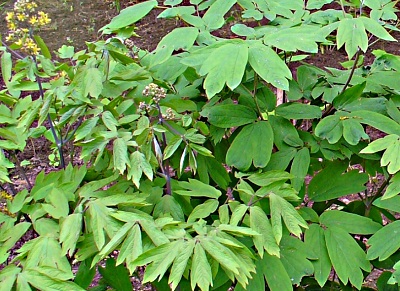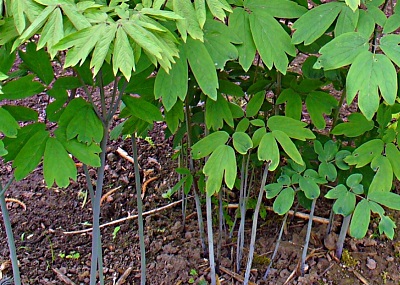Blue Cohosh – Caulophyllum thalictroides
|
Current Demand = Normal |
Parts Used: Rhizome and Root |
Family: Berberidaceae
Common names: squaw root, papoose root, beechdrops, blueberry, blue ginseng…
Description
Caulophyllum or blue cohosh is a perennial herbaceous plant indigenous to the Eastern part of the USA and Canada where it prefers moist, rich soil. It grows up to a three feet high and has a round, simple, erect stem, large three-lobed leaves and racemes of small yellow-green six-petaled flowers. The fruit is a pea-sized dark blue berry borne on a fleshy stalk. The rhizome is hard and knotted and usually very matted on the bottom side.
From the single stalk rising from the ground, there are three branches plus a fruiting stalk. Leaves are tulip shaped, entire at the base but serrate at the tip.
Growing region: Blue cohosh is found thru-out the Eastern United States and Canada. It is common in the Midwest from the Appalachian range west to Oklahoma. It is often found in rich moist woods in thickets out of direct sunlight.
Planting
Growth on any major scale has never been done with Blue Cohosh. One reason is that growth from seed is very slow, up to 5 years before the root can be harvested.
Blue Cohosh prefers a moist soil with high humidity and adequate drainage. It is best grown from root division and planted in either the fall for spring. If you can grow Ginseng or Goldenseal, then the soil is ideal for Blue Cohosh. It grows best in areas with at least 70% shade. It requires minimum of care and is not subject to pests.
Harvesting/Drying
Parts Used: rhizome and root
For maximum potency, Blue cohosh should be harvested in the late summer and fall. Only the plants roots have medicinal properties and market value. Gather the larger more mature plants leaving plenty of younger smaller plants to seed the area for future harvest.
After harvest, the roots should be washed in cold water and all foreign matter (rocks, dirt and other roots) must be removed.
Unless your buyer is purchasing fresh dug roots (which they often do), the roots need to be dried. Large roots may need to be broken in half to aid in drying. Blue cohosh roots can be dried in the sun although if possible dry indoors in a well ventilated barn loft or attic to protect from the elements. If natural heat is not available, you may need to add heat and a fan for continuous airflow. The key to drying any root, herb or bark in an even combination of heat and airflow. Never use an oven or microwave.
Blue cohosh will be completely dry (largest stem will snap not bend) in 3-8 days depending on the size of the root and the drying conditions. Place the herb carefully into a cardboard box or paper bag for storage in a dry area until you are ready to sell or use. Do not store the roots in plastic or it will mold.
 Root Buyer
Root Buyer
